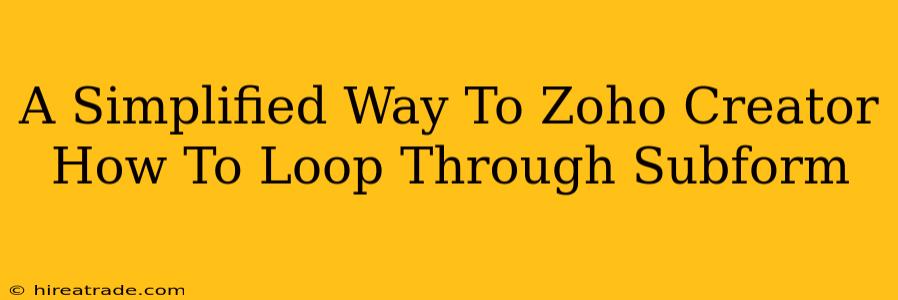Zoho Creator's power lies in its ability to handle complex data relationships. One common task that can seem daunting is looping through data within subforms. This guide breaks down how to efficiently navigate and process information nested within your subforms, making your Zoho Creator applications more dynamic and powerful.
Understanding Subforms in Zoho Creator
Before diving into looping, let's clarify what subforms are. Essentially, they're a way to embed related data within a main form. Think of it like a table within a larger document. Each row in that table represents a separate record linked to the main record. This structure is perfect for managing lists of items, addresses, or any other related information within a single record.
The Challenge: Why Looping is Necessary
Manually accessing data within a subform for each individual record is tedious and inefficient, especially when dealing with a variable number of records. Looping provides an automated solution, allowing you to process all subform data systematically.
Looping Techniques: A Simplified Approach
Zoho Creator doesn't offer a direct "for" or "while" loop like you might find in traditional programming languages. However, we can achieve the same functionality using Deluge scripting and leveraging Zoho Creator's built-in functions.
Method 1: Using getChildRecords and for each
This is the most common and straightforward method. The getChildRecords function retrieves all records from the subform, and the for each loop iterates through them.
Example:
Let's say you have a main form "Orders" with a subform "OrderItems." Each "Order" can have multiple "OrderItems." To calculate the total cost of all items in an order, you could use the following Deluge script:
// Get the current Order record
local orderRecord = input.record;
// Get all OrderItem records associated with the current Order
local orderItems = orderRecord.getChildRecords("OrderItems");
// Initialize total cost
local totalCost = 0;
// Loop through each OrderItem
for each item in orderItems
{
// Add the item's cost to the total
totalCost = totalCost + item.cost;
}
// Return the total cost
return totalCost;
This script efficiently sums the cost of all items in an order. You can adapt this approach to perform other actions on each subform record. Remember to replace "OrderItems" and "cost" with your actual subform name and field name.
Method 2: Utilizing getRecordCount for Conditional Logic
Sometimes you might need to execute a different set of actions depending on the number of subform records. This is where getRecordCount proves valuable. It allows you to determine the number of subform records before processing.
Example:
local orderRecord = input.record;
local orderItems = orderRecord.getChildRecords("OrderItems");
local itemCount = orderItems.getRecordCount();
if (itemCount > 0) {
// Process subform data - your logic here
} else {
// Handle the case where there are no subform records
}
This approach improves efficiency by avoiding unnecessary processing when a subform is empty.
Best Practices for Subform Looping
- Error Handling: Always include error handling in your Deluge scripts to gracefully manage potential issues, such as missing data or unexpected input.
- Optimization: For large datasets, consider optimizing your loops to avoid performance bottlenecks. Batch processing or using more efficient data structures can help.
- Clear Naming Conventions: Use meaningful names for variables and functions to improve code readability and maintainability.
By mastering these looping techniques, you unlock the full potential of Zoho Creator's subforms, allowing you to build sophisticated and data-driven applications. Remember to consult the official Zoho Creator documentation for the most up-to-date information on Deluge scripting functions.

